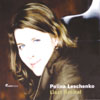Liszt Piano Works
A phenomenal technique, to be sure, but the music can suffer
View record and artist detailsRecord and Artist Details
Composer or Director: Franz Liszt, Johann Sebastian Bach
Genre:
Instrumental
Label: Avanti
Magazine Review Date: 11/2007
Media Format: CD or Download
Media Runtime: 57
Mastering:
Stereo
DDD
Catalogue Number: AVANTI10272

Tracks:
| Composition | Artist Credit |
|---|---|
| (6) Preludes and Fugue (Bach), Movement: A minor, BWV543 |
Franz Liszt, Composer
Franz Liszt, Composer Polina Leschenko, Piano |
| (3) Sonatas and 3 Partitas, Movement: Partita No. 2 in D minor, BWV1004 |
Johann Sebastian Bach, Composer
Johann Sebastian Bach, Composer Polina Leschenko, Piano |
| Faust (Gounod) Waltz |
Franz Liszt, Composer
Franz Liszt, Composer Polina Leschenko, Piano |
| Sonata for Piano |
Franz Liszt, Composer
Franz Liszt, Composer Polina Leschenko, Piano |
Author: Jeremy Nicholas
Who said anticipation was better than realisation? In the Bach-Liszt, Polina Leschenko sets off at a blistering pace and leggiero, linking the end of the Prelude to the opening of the Fugue with the pedal, playing helter-skelter until the final bar, the last chord of which, in my score, is in A minor. Here it is wryly twisted into A major. Ah well. Strange, but at least it didn’t plod. That was before the Chaconne, probably the fastest ever recorded. One’s suspicion is confirmed: a phenomenal technique but one that robs the music of depth and dignity. Worse, it lapses into textual and musical incoherence.
To the showy Faust Waltz, Leschenko brings astonishing agility alternating with over-pedalled lyrical passages. This old warhorse needs careful handling, and if you are going to attempt to play the stretta at presto/prestissimo as marked, then you had better have the wherewithal to swallow it whole like Egon Petri or, better still, have something in reserve like Cziffra who offers a scintillating demonstration of articulation and controlled power at high speed. Approximation will not do. And certainly not in a great work like the Sonata, about which the least said the better. To ride roughshod over Liszt’s agogics and ignore important structural devices (at 6'26", for instance, when the left hand has the main subject in counterpoint) can be construed as careless, but when faced with a litany of quite perverse ideas and frequent rhythmic instability, then Miss Leschenko really should go back and think it through again.
To the showy Faust Waltz, Leschenko brings astonishing agility alternating with over-pedalled lyrical passages. This old warhorse needs careful handling, and if you are going to attempt to play the stretta at presto/prestissimo as marked, then you had better have the wherewithal to swallow it whole like Egon Petri or, better still, have something in reserve like Cziffra who offers a scintillating demonstration of articulation and controlled power at high speed. Approximation will not do. And certainly not in a great work like the Sonata, about which the least said the better. To ride roughshod over Liszt’s agogics and ignore important structural devices (at 6'26", for instance, when the left hand has the main subject in counterpoint) can be construed as careless, but when faced with a litany of quite perverse ideas and frequent rhythmic instability, then Miss Leschenko really should go back and think it through again.
Discover the world's largest classical music catalogue with Presto Music.

Gramophone Digital Club
- Digital Edition
- Digital Archive
- Reviews Database
- Full website access
From £8.75 / month
Subscribe
Gramophone Full Club
- Print Edition
- Digital Edition
- Digital Archive
- Reviews Database
- Full website access
From £11.00 / month
Subscribe
If you are a library, university or other organisation that would be interested in an institutional subscription to Gramophone please click here for further information.




